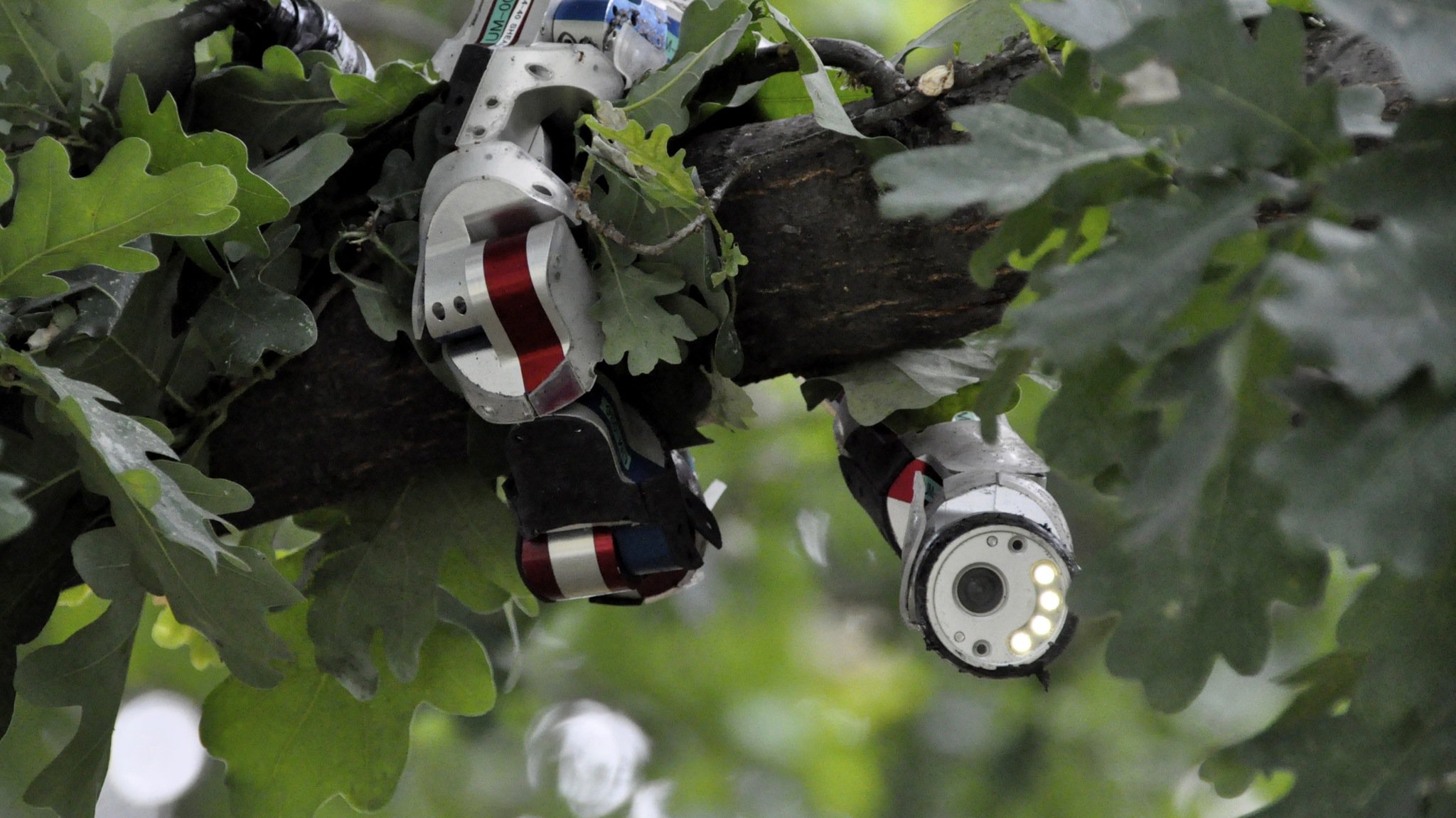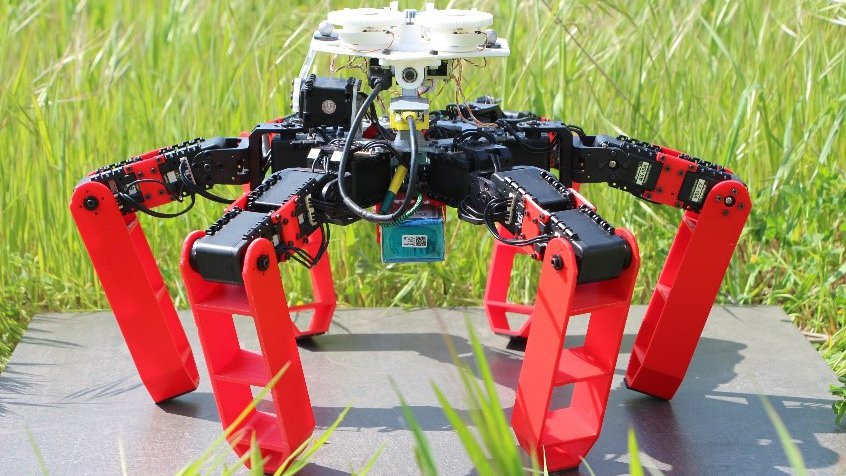Let a Snake-Inspired Robot Be Your Hero Today
Snake robots might come in handy for surgery, search-and-rescue missions, and even space exploration—but they’re nothing without the slithering serpents that inspire their design.

It may have snake eyes, sure, but this serpentine robot—and others like it—could still bring good fortune. Image Credit: Biorobotics Laboratory, Carnegie Mellon University
In the eyes of humans, snakes get a pretty bad rap. But though we malign them for gobbling up Voldemort’s victims and casually purveying Original Sin, these slithering serpents may yet be the heroes we need.
Researchers around the world are now taking cues from snakes to design a new generation of wriggly robots. Adopting snakes’ eerie modus operandi of limbless locomotion, these mobile machines may soon prove useful in medicine, search-and-rescue missions, and even space exploration.
Snakes are hardly the only animals to inspire robots. But they may be some of the most versatile: Snakes can speed along at over 12 miles per hour, scale trees, ford rivers, and squeeze into small spaces—not necessarily in spite of their lack of arms or legs, but perhaps because of it.
“Having a long, flexible body can be adapted to a lot of different tasks,” says Perrin Schiebel, a physicist studying snake mechanics at the Georgia Institute of Technology. “There are situations when having limbs is just not what you want.”
Arms and legs can certainly come in handy, but when you’re in a jam or plowing through dense, unpredictable terrain, even the smallest of limbs can be a drag. Already, snake-like robots have wormed their way into the hearts of many—by performing delicate surgeries, that is. One such robot has the flexibility and precision to wriggle through a small hole in the chest of a pig and burn away bits of damaged heart tissue, all without cracking open the ribcage.
And these tunneling tricks are useful outside the body, too. In recent years, Howie Choset, a roboticist at Carnegie Mellon University who helped design the surgical probe, has put snakebots to work in the arena of search and rescue. In the aftermath of a 2017 earthquake in Mexico City, his group deployed a three-foot-long, camera-toting robot into a collapsed building to search for survivors.

The Carnegie Mellon University Biorobotics Laboratory deployed a snake robot to search for survivors in a collapsed Mexico City building after an earthquake in September 2017. Image Credit: Biorobotics Laboratory, Carnegie Mellon University
“Snake robots could be the best thing for search and rescue, and sometimes, they’re the only option in confined spaces,” says Julian Whitman, a roboticist in Choset’s research group who led the effort in Mexico City. “There’s not any other tool that has the same capabilities: They’re all terrain, they fit through small spaces and move over large ones.”
Those qualities also mean that a robot like this is, by definition, more than a one-trick pony, Whitman notes. Other versions of the Choset Lab’s search-and-rescue snake robot also make quick work of clambering up trees, lampposts, and human legs.
Of course, snake robots are far from perfect, and there’s still a lot to learn from the snakes themselves. Schiebel, the Georgia Tech physicist, has dedicated the past several years to studying how snakes cope with obstacles—a feat that nature has mastered, but robotics has not. Her most recent work, supervised by Daniel Goldman and published today in the journal PNAS, shows that when it comes to collisions, some snakes are actually masters of nonchalance, letting their surroundings shape their path.
Confronted with a roadblock, most animals will internalize that information and course correct to avoid a crash. Not so for snake species like the western shovelnose, which charges ahead in an undulating S-shape and smashes headlong into whatever object stands in its way. Upon impact, the snake’s sinewy body buckles and ricochets off the offending object—then continues blithely onward. “They just bounce off and keep going at whatever angle they bounce off at,” Schiebel says. And because these snakes slither in waves, Schiebel found that these collision patterns are easy to track and predict: They resemble how light or subatomic particles diffract.
If the same holds true for a robot, that could be a huge computational weight off both machinery and operator. Any robot that’s able to take collisions in stride and still maintain coordinated movements is one that doesn’t have to spend as much time and energy on avoiding obstacles in the first place. “If you predict how a robot might deflect off something, that makes controlling it easier,” Whitman says.
With all its bells and whistles and metallic innards, though, a snake-inspired robot is a far cry from, say, an actual snake (phew). For one thing, robots aren’t made of flesh and bone (for now), and their stiff, segmented bodies can’t deform in quite the same way.
But the work of Jennifer Rieser, also a physicist working with Goldman at Georgia Tech, has shown that when hard-bodied robots move in serpentine waves, they, too, seem to be deflected in predictable ways when they encounter obstacles. “These studies are a starting point for understanding how to manage collisions, and have them not be catastrophic for robots,” she says.
The hope, Goldman says, is that these studies will eventually enable snake robots to safely go just about anywhere that snakes can—and humans can’t.
And the sky’s far from the limit. In other parts of the world, roboticists like Aksel Transeth, of SINTEF in Norway, envision a future in which snakes may even slither into outer space. Since 2003, his group has been working with the Norwegian University of Science and Technology (NTNU) to develop snake-inspired robots for applications ranging from firefighting to inspecting hard-to-reach areas on the International Space Station. But Schiebel is particularly excited for an even loftier goal: the exploration of new worlds.
Undeterred by obstacles, snake robots might just be the perfect mix of hardy and flexible. “If you wanted to go to a planet, but you don’t know what the surface is like, maybe the first thing you send is a snake robot,” Schiebel says. It may sound far-fetched, but Transeth is already hopeful that snake robots will someday traverse lunar lava tubes and scout the surfaces of low-gravity bodies like asteroids and comets.

A western shovelnosed snake moves through a set of rubber pegs. The pegs altered the direction of the snake's travel, but didn't change the S-shaped wave the snake moved in. Image Credit: Allison Carter, Georgia Institute of Technology
It’s enough to make you rethink the whole limb thing. It’s actually thought that snake ancestors once had legs, but scrapped them entirely at some point along their evolutionary trajectory. “To me, as a person with limbs, that at first seems strange,” Schiebel says. “I mean, if you can have legs, why wouldn’t you?”
But what might be viewed as a handicap for another animal is perhaps the very thing that has enabled snakes to scoot seamlessly through just about every habitat the world has to offer.
“Clearly, they’re doing something right,” Rieser says. “We have a lot to learn from them.”



